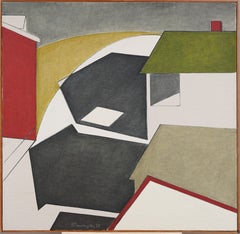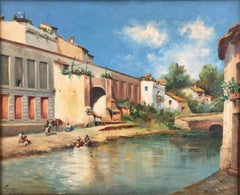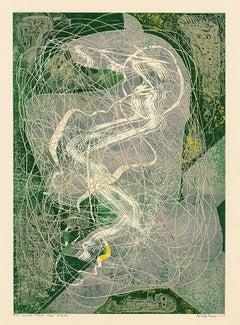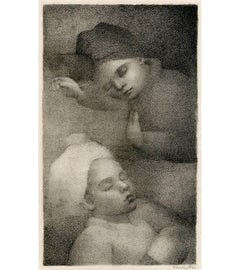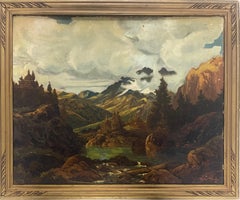1940s Art
to
1,352
2,957
1,175
986
406
259
Overall Width
to
Overall Height
to
7,535
21,269
158,666
232,723
1,967
2,237
4,902
6,409
5,807
13,258
19,620
25,623
18,274
13,565
5,377
2,149
453
326
213
178
117
80
67
49
20
10
2
1
3,353
2,191
161
3,108
1,527
1,205
996
956
615
402
390
365
355
294
269
262
256
235
187
163
145
144
143
1,999
1,515
1,267
948
698
117
108
77
57
48
1,531
934
3,784
1,826
Period: 1940s
Antique American Modernist Abstract Houses Architecture Precisionist NY Painting
Located in Buffalo, NY
Oil on canvas. Framed. Signed.
Category
Modern 1940s Art
Materials
Canvas, Oil
$1,020 Sale Price
20% Off
Seville Guadalquivir River Spain oil on canvas painting
By Carlota Rosales Martínez de Pedrosa
Located in Sitges, Barcelona
Carlota Rosales Martínez de Pedrosa was born in Madrid in 1872 and was the second daughter of the painter Eduardo Rosales, after the birth the Rosales...
Category
Realist 1940s Art
Materials
Oil, Canvas
'Sylvan Maze' — Mid-century American Surrealism
Located in Myrtle Beach, SC
Robert Vale Faro, 'Sylvan Maze', color lithograph, 1946, edition 20. Signed, dated, titled and numbered '112' and '11/20' in pencil. A fine, richly-inked impression with fresh colors, on heavy, off-white wove paper; full margins (1 to 1 1/2 inch), in excellent condition. Image size 13 11/16 x 9 11/16 inches; sheet size 16 1/8 x 12 5/16 inches. Scarce. Matted to museum standards, unframed.
ABOUT THE ARTIST
Robert Vale Faro (1902-1988) was a modernist architect and artist associated with the Chicago Bauhaus. He received his degree in architecture and design from the Armour Institute in Chicago and worked at L'Ecole des Beaux-Arts, Paris, from 1924-27, where he was influenced by Harry Kurt Bieg and Le Corbusier. Upon his return to Chicago, Faro worked with the important modernist Chicago architects George and William Keck under Louis Sullivan.
Faro founded the avant-garde printmaking group Vanguard in 1945. The group counted Atelier 17 artists Stanley William Hayter, Sue Fuller...
Category
American Modern 1940s Art
Materials
Lithograph
Untitled (Children Sleeping)
By Amalia Polleri
Located in Myrtle Beach, SC
Amalia Polleri, 'Untitled (Sleeping Children)', Conté crayon on cream wove drawing paper, signed and dated '43 in ink beneath the image, lower right; with 1/4 margins all around. Arc...
Category
Modern 1940s Art
Materials
Conté
Antique Horse and Carriage Danish Winter Landscape Oil Painting circa 1940
Located in Douglas Manor, NY
3910C Antique impressionistic winter landscape.Oil on canvas applied to board
Displayed in a gilt wood frame,
Signed lower left by Johanssen.
Image size 17.5 H x 23.5 W
Category
1940s Art
Materials
Oil
$600 Sale Price
38% Off
“Mountain Scene”
Located in Warren, NJ
This is an Robert W. Wood Original Oil Painting 1941. Measures 34x28. Condition report painting has some damage. Small hole on top, hole that’s been repaired in the center. Minor scr...
Category
1940s Art
Materials
Oil
'Budapest, Váci Street in the Snow', France, Salon d' Automne, Legion of Honour
Located in Santa Cruz, CA
Signed lower right, 'Kunffy' for Lajos Kunffy (Hungarian, 1869-1962); additionally titled, verso, 'Budapest 1942, A váci utca ...'
A Hungarian winter landscape showing a birds-eye v...
Category
Impressionist 1940s Art
Materials
Oil, Illustration Board
Grant Wood Original Pencil Signed Lithograph, 1940 - February
By Grant Wood
Located in Phoenix, AZ
Original pencil signed Grant Wood lithograph, "February," created 1940.
A fine impression and one of the most important of the 19 lithographs created by the painter of "American Goth...
Category
1940s Art
Materials
Paper, Lithograph
Virgin Mary and Child Jesus oil on canvas painting
Located in Sitges, Barcelona
Title: Virgin Mary and Child Jesus
Artist: Francisco Ribera Gómez (1907-1990)
Technique: Oil on canvas
Dimensions: 31.9 x 25.6 inches (unframed)
Date of creation: 1942
Style: Classical Academicism with Renaissance influences
Description of the Artwork
The painting depicts the Virgin Mary holding the Child Jesus in a tender and intimate moment. Warm colors, primarily reds, greens, and soft flesh tones, enhance the devotional nature of the scene. The use of golden halos, symbolizing sanctity, along with serene and realistic expressions, directly connects with the Renaissance pictorial tradition.
The style belongs to classical academicism, characterized by a balanced composition, meticulous drawing, and a masterful use of chiaroscuro to give volume and depth to the figures. The detailed rendering of the flesh tones and draperies amplifies the spirituality and solemnity of the piece, evoking the works of great masters such as Raphael and Murillo.
Artist's Biography
Francisco Ribera Gómez (1907-1990) was a prominent 20th-century Spanish painter known for his depictions of religious scenes, female portraits, and costumbrist works. Trained at the Royal Academy of Fine Arts of San Fernando, Ribera Gómez received numerous accolades and was regarded as one of the great exponents of Spanish academicism. His work combines a rigorous technical foundation with luminous sensitivity and an idealized sense of beauty.
Influences and Comparisons
Francisco Ribera Gómez's work can be compared to other academic and religious artists who share a similar aesthetic:
Bartolomé Esteban Murillo: In the emotional and approachable treatment of religious themes.
William-Adolphe Bouguereau: For the idealization of human figures and technical mastery.
Raphael (Raffaello Sanzio): For harmonious composition and the depiction of the Virgin Mary.
Within the Spanish tradition, his style recalls Eduardo Rosales...
Category
Academic 1940s Art
Materials
Canvas, Oil
$2,393 Sale Price
20% Off
Surrealist composition
Located in Henderson, NV
Medium: collotype (after the Miro lithograph). Printed in 1947 in an edition of 1500 by Meriden Gravure and published by Curt Valentin for "The Prints of Joan Miro" portfolio. Size: ...
Category
Surrealist 1940s Art
Materials
Photogravure
'Napoleonic Guard at the Cathedral of Uspensky Sobor', Moscow, French Militaria
Located in Santa Cruz, CA
Initialed lower left, 'C.H.' for Charles Constantine Hoffbauer (French, 1875-1957) and painted circa 1900.
Accompanied by the original artist-signed mat, original backing with inscr...
Category
Realist 1940s Art
Materials
Paper, Gouache
Lady Seated - Mid 20th Century Belgian Impressionist Portrait Oil Painting
Located in Sevenoaks, GB
A beautiful signed and dated 1943 impressionist oil on board depicting a seated lady, by Belgian painter Jacques Hanot (Jacano).
Excellent quality and condition work, siggned lower ...
Category
Impressionist 1940s Art
Materials
Oil, Board
Got Mit Uns - Rare Book Illustrated by Renato Guttuso - 1947
Located in Roma, IT
Got mit uns is an original modern rare book illustrated by Renato Guttuso (Bagheria, 1911 – Rome, 1987) in 1947.
Original Edition.
715 numbered copies.
Published by La Margherita,...
Category
Modern 1940s Art
Materials
Paper, Offset
A Quirky 1940s Mid-Century Modern Still Life by Chicago Artist, Harold Haydon
Located in Chicago, IL
A charming, colorful and quirky 1940s Mid-Century Modern Still Life, "Elephant and Red Pillow" by notable Chicago Artist, Harold Haydon Artwork size: 8 1/2 x 10 1/2 inches; Framed...
Category
American Modern 1940s Art
Materials
Oil, Board
Antique American Realist Chow Chow Dog Portrait Framed Signed Oil Painting
Located in Buffalo, NY
Vintage American realist dog portrait oil painting. Oil on board. Framed. Signed. In excellent original condition. Handsomely framed in a modern wood molding. Excellent conditio...
Category
Realist 1940s Art
Materials
Oil, Board
$1,020 Sale Price
20% Off
Orpheus #1 - Gelatin Silver Photograph Balanchine Ballet Classical Male Nudes
Located in Glenford, NY
George Platt Lynes 1948 Photograph #1 of Balanchine Ballet ‘Orpheus’.
George Platt Lynes rare original vintage 1948 gelatin silver photograph (dated by the NY City Public Library) of nude dancers Francisco Moncion and Nicholas Magallanes in George Balanchine's iconic mid-20th Century ballet 'Orpheus'. Stamped on verso in dark blue ink at upper center, "GEORGE PLATT LYNES/145 EAST 52 STREET NEW YORK”. Photo shoot took place in NYC. Costumes and Set by ISAMU NAGUCHI. Photo is 7 5/8 x 9 1/4 inches, soft satin finish in excellent condition.
This photograph is from Francisco Moncion's original collection given to him by George Platt Lyons. It is one of 14 different poses in the 'Orpheus' series. 8 different photographs are remaining for sale and are available on request. All are original Platt Lyons gelatin silver prints original to Moncion's collection and are stamped by the photographer. Photographs from this celebrated series are in the permanent collections of the Metropolitan Museum of Art (NYC), Museum of Modern Art (MOMA, NYC), the NYC Public Library, and many university art archives.
George Platt Lynes (1907–1955), was a gregarious American portrait, dance, fashion, and male nude photographer whose career spanned the late 1920s through the early 1950s. From age eighteen, Lynes entered the cosmopolitan world of the American expatriate community in Paris when he became acquainted with the salon of Gertrude Stein and Alice B. Toklas. He began photographing authors like Stein, Jean Cocteau, André Gide, and Colette and soon established himself as one of the premier fashion photographers in the Condé Nast stable, documenting the ballet companies of George Balanchine/Lincoln Kirstein, and pursuing a private obsession with seductive images of young male nudes rarely published in his lifetime.
Orpheus represents a major 20th Century artistic collaboration between composer Igor Stravinsky, choreographer George Ballanchine, and artist/designer Isamu Naguchi. Orpheus is a thirty-minute neoclassical ballet composed by Igor Stravinsky in collaboration with choreographer George Balanchine in Hollywood, California in 1947. The work was commissioned by Ballet Society, later renamed New York City Ballet, which Balanchine founded with Lincoln Kirstein. Sets and costumes were created by Isamu Noguchi. Noguchi’s lyre harp from the production became the symbol of the New York City Ballet.
Francisco Moncion (July 6, 1918 – April 1, 1995) was a charter member of the New York City Ballet. Over the course of his forty year career, choreographers George Balanchine, and Jerome Robbins in the New York City Ballet created 22 major roles for Moncion including the Dark Angel...
Category
Modern 1940s Art
Materials
Silver Gelatin
“Mother and Child”
Located in Southampton, NY
Original oil on canvas painting by the well known Russian/American artist, Nahum Tschacbasov. Signed middle right and dated 1943. Condition is very good. Unlined canvas. The painti...
Category
Abstract Expressionist 1940s Art
Materials
Canvas, Oil
$4,800 Sale Price
61% Off
"Cubist Landscape" Albert Heckman, American Modernist, Fractured Landscape
Located in New York, NY
Albert Heckman
Cubist Landscape
Signed lower right
Oil on canvas
21 3/4 x 30 inches
Albert Heckman was born in Meadville, Western Pennsylvania, 1893. He went to New York City to tr...
Category
American Modern 1940s Art
Materials
Canvas, Oil
A Captivating Modern Seated Nude in a Studio Interior by Francis Chapin
Located in Chicago, IL
A captivating, Modern portrait painting of a female nude seated in a quiet studio interior by famed Chicago artist, Francis Chapin (Am. 1899-1965). A sensitive, skilled portrait of ...
Category
American Modern 1940s Art
Materials
Oil, Masonite
WOMAN DRAWING
Located in Portland, ME
Packard, Emmy Lou (American, 1914 - 1998). WOMAN DRAWING. Color Woodcut, not dated. Edition size not known. Signed in pencil. 18 1/16" x 14 1/8" inches (...
Category
1940s Art
Materials
Woodcut
1943 Focke-Wulf FW 190 Würger Luftwaffe World War 2 airplane recognition poster
Located in London, GB
To see our other original vintage propaganda posters, scroll down to "More from this Seller" and below it click on "See all from this Seller" - or send us a message if you cannot find the poster you want.
US Naval Aviation Training Division
Focke-Wulf Fw 190 - World War II aeroplane
Aeroplane identification poster, 1943
63x47cm
A particularly unusual style of aeroplane identification poster, owing to the very arty images. Most such posters rely on very plain silhouettes, this series - and we have several in this series - have a much more arty approach to the task with shading and an interesting angle view.
The Würger (in English, Shrike) is a single-seat single-engined fighter airplane widely used during World War II by the Germans. Designed in 1936 over 20,000 were built, beginning operations in August 1941 outclassing the Spitfire Mk V...
Category
Modern 1940s Art
Materials
Lithograph
Tauromaquia - Plate 33
Located in Henderson, NV
Medium: heliogravure (after the etching from Goya's Tauromaquia series). Printed in 1947 in a limited edition of 500 on Guarro laid paper, and published in Barcelona by Ediciones Ome...
Category
1940s Art
Materials
Photogravure
Gauguin, The Long Night (Te Po), Gauguin (after)
By Paul Gauguin
Located in Southampton, NY
Woodcut on vélin Utopian paper. Unsigned and unnumbered, as issued. Good Condition. Notes: From the folio, Gauguin, A portfolio of 12 color woodblocks, Paul Gauguin, French, 1848-1903 from the collection of the Museum Of Fine Arts, Boston, 1946. Rendered by Albert Carman (1899-1949); published the Museum Of Fine Arts, Boston and The Studio Publications, Inc., New York and London; printed by Holme Press Inc., New York, in an edition of MMMD. Excerpted from the folio, Paul Gauguin and Emil Bernard at Pont-Aven, Brittany, in 1888, each made a bas-relief, wooden panel to decorate a piece of furniture for a friend. In order to keep a record of their designs, a few inked impressions were made on paper. The illustration at left is a reproduction of a print which is possibly one of the above mentioned. It is further possible that this experiment later gave Gauguin the idea of making woodcuts. Just as his work in painting expressed a revolt against the overemphasis on factual representation of the nineteenth century in favor of decorative pattern and color, so also his woodcuts leaned strongly to the same side of the balance. Ten of the cuts reproduced (all excepting Soyez Amoureuses and Changement de Residence), which constitute the whole of his best known series, were made at Pont-Aven beginning in the fall of 1894, after Gauguin's return from his first trip to Tahiti and after he broke his ankle. They were at first roughly cut with a common carpenter's gouge, and the flat surfaces sandpapered and engraved with a sharp in-strument, perhaps an engraver's burin. A few trial proofs were printed in black ink only. Then the hollows were deepened with a woodcutter's gouge and highlights were added. An edition of thirty to fifty impressions of each subject, with the addition of color blocks (one, two or three), was made by Louis Roy...
Category
Post-Impressionist 1940s Art
Materials
Woodcut
$716 Sale Price
20% Off
Autumn Landscape — 1940s Post-Impressionism
Located in Myrtle Beach, SC
Henri Pierre Fortier, Untitled (Autumn Landscape), gouache, c. 1940s. Signed in ink. Inscribed 'To my Friend CLINTON R. MULFORD'. A fine, painterly watercolor, with rich, layered colors, on heavy dark brown drawing paper with approximately 1/4 inch margins; an unfinished figurative sketch...
Category
Impressionist 1940s Art
Materials
Gouache
Point Judith
Located in Los Angeles, CA
Born in New York City, Reynolds Beal's year of birth is reported as being 1866 as well as 1867. If one follows the most extensively researched source produced in consultation with t...
Category
Post-Impressionist 1940s Art
Materials
Oil
$17,500 Sale Price
30% Off
Blizzard in Woods
Located in Fairlawn, OH
Blizzard in Woods
Graphite on paper, c. 1945-1963
Unsigned
Provenance: Sid Deutsch Gallery, New York
Annotated with notes for completing the drawing. Deutsch Gallery has handled Bur...
Category
American Modern 1940s Art
Materials
Graphite
Vintage French Fashion Poster
Located in London, GB
Vintage French fashion poster, original lithograph, by Jean Choiselat, (1947). Take a step back to the 1940s to immerse yourself in the surprising work ...
Category
1940s Art
Materials
Lithograph
$382 Sale Price
30% Off
lithograph
Located in Henderson, NV
Medium: lithograph (after the drawing). This impression in violet ink was printed in France in 1944 for the rare "Correspondances" portfolio, published by Teriade in a limited editio...
Category
1940s Art
Materials
Lithograph
Fernand Leger, After the Flood, from The Illuminations, 1949
Located in Southampton, NY
This exquisite lithograph by Fernand Leger (1881–1955), titled Apres le deluge (After the Flood), originates from the 1949 folio Les Illuminations, lithographies originales de Fernan...
Category
Modern 1940s Art
Materials
Lithograph
$6,796 Sale Price
20% Off
Notre Dame Cathedral and Ile Saint Louis Oil on Canvas Painting by Paul Lambert
Located in Atlanta, GA
A unique oil painting on canvas signed by Paul Lambert (1910–1970), a renowned French artist celebrated for his evocative portrayals of Parisian landscapes.
This rare piece exemplifi...
Category
Post-Impressionist 1940s Art
Materials
Canvas, Oil
Nebraska Evening
Located in London, GB
A fine impression with good margins published by Associated American Artists.
Category
American Modern 1940s Art
Materials
Lithograph
original woodcut for Pierre a feu Les miroirs profonds
Located in Henderson, NV
Medium: original woodcut. Printed in 1947 in an edition of 950 on Rives wove paper for "Pierre a feu / Les miroirs profonds" and published in Paris by Maeght. Image size: 8 1/4 x 6 1...
Category
1940s Art
Materials
Woodcut
Mid-Century Ceramic Sculpture of a Seated Female, Cleveland School Artist
Located in Beachwood, OH
Walter Sinz (American, 1881-1966)
Seated Female, c. 1940
Ceramic
6 x 3.5 x 3.5 inches
Walter A. Sinz was an American sculptor born in Cleveland, Ohio on July 13, 1881. Sinz’s fathe...
Category
1940s Art
Materials
Ceramic
Autumn Forest - Mid Century Abstracted Fauvist Landscape
Located in Soquel, CA
Gorgeous mid century fauvist watercolor landscape with lush, vivid trees and distant houses by Emily Shotwell Goeller-Wood (American, 1887-1965). Presented in a rustic giltwood frame...
Category
Fauvist 1940s Art
Materials
Paper, Watercolor
$1,320 Sale Price
20% Off
Exhibited American Abstract Expressionist Modern Mid Century Framed Oil Painting
Located in Buffalo, NY
Vintage American school abstract expressionist oil painting by Ray Prohaska (1901 - 1981). Oil on board. Very nice period frame. Signed. Exhibited at Mortimer Levitt Gallery. Im...
Category
Abstract 1940s Art
Materials
Canvas, Oil
Mid 20th Century Impressionist Original Oil Landscape of Shongum, New Jersey
Located in Soquel, CA
Beautiful impressionistic landscape of Shongum Lake, New Jersey countryside in Spring with Stream and blossoms by Rudolph J. Eicher (1884 - 1958), Circa 1940s. Bright springtime fo...
Category
American Impressionist 1940s Art
Materials
Linen, Oil, Panel
Mid Century Colorado River Landscape
Located in Soquel, CA
Beautiful mid century impressionist landscape of Colorado River and hills by Wilfred A. Readio (American, 1895-1961), c.1940. Unsigned; purchased as part of collection of artist's wo...
Category
Tonalist 1940s Art
Materials
Masonite, Oil
Antique American Modernist Framed Flower Still Life interior Signed Oil Painting
Located in Buffalo, NY
Antique American school modernist still life painting. Oil on canvas. Framed. Signed.
Category
Modern 1940s Art
Materials
Canvas, Oil
$396 Sale Price
20% Off
Very Large ca. 1940s Painting of a Female Rower Holding Oars by Francis Chapin
Located in Chicago, IL
Very large, unique 1940s painting of a standing female rower holding a pair of oars by famed Chicago Modern artist, Francis Chapin. Image size: 65 x 44 inches. Framed size: 65 1/2 x 44 1/2 inches. Unsigned canvas...
Category
American Modern 1940s Art
Materials
Oil, Canvas
Paloma Picasso (1949) - Vallauris - Colour screen printing
Located in Varese, IT
Colour screen printing
Limited edition of 200 copies, numbered as 78/200 in lower left corner.
Signed in pencil by artist in lower right corner.
Paper size: 69,7 x 49 cm
Very good c...
Category
Abstract 1940s Art
Materials
Screen
Carmen, The Young Sleeper - Original Etching (Cramer #52)
Located in Paris, IDF
Pablo PICASSO
Carmen, The Sleeping Woman, 1949
Original burin engraving (Atelier Lacourière, Paris)
Unsigned
On Montval wove paper 33 x 26 cm (12.9 x 10.2 in)
REFERENCES :
- Catal...
Category
Modern 1940s Art
Materials
Etching
Disrobing Her with His Own Hand..., from Four Tales from the Arabian Nights
By Marc Chagall
Located in OPOLE, PL
This work will be exhibited at Art on Paper NYC, September 4–7, 2025.
–-
Marc Chagall (1887-1985) - Disrobing Her with His Own Hand..., from Four Tales from the Arabian Nights
Lit...
Category
Symbolist 1940s Art
Materials
Lithograph
$33,505 Sale Price
20% Off
La Corderie et le Pain de Sucre by Paulémile Pissarro - Snow Painting, Oil
Located in London, GB
La Corderie et le Pain de Sucre by Paulémile Pissarro (1884-1972)
Oil on canvas
65 x 54 cm (25 ⁵/₈ x 21 ¹/₄ inches)
Signed lower left, Paulémile- Pissarro-
Signed and titled on the r...
Category
Post-Impressionist 1940s Art
Materials
Canvas, Oil
Antique Chinese Reverse Oil Painting on Glass Village Landscape 1940
Located in Douglas Manor, NY
5-3536 Chinese Landscape reverse oil Painting on glass with gilt detailing
Set in a gilt wood frame
Image size 9.5x7.5"
Category
1940s Art
Materials
Oil
1947 Abstract Biomorphic Painting by Leo Cahn
Located in New York, NY
Leo Cahn
Untitled, 1947
Oil on board
35 3/4 x 23 3/8 in.
Framed: 42 1/2 x 30 1/2 x 2 in.
Signed and dated lower left
Category
Abstract 1940s Art
Materials
Oil, Board
French Oil Painting - The Cat's Meow
Located in Houston, TX
Whimsical oil on paper painting of a tabby cat resting on a rug and backed by large abstract cat forms, circa 1940. Signed lower left.
Original artwork on paper displayed on a whit...
Category
1940s Art
Materials
Oil, Paper
$2,800 Sale Price
20% Off
School Children, L'Ile Saint Louis, Paris — Mid-Century Photogravure
Located in Myrtle Beach, SC
Rémy Duval, 'School Children, L'ile Saint Louis, Paris', photogravure, 1946. A fine, richly-inked impression in warm black ink, on cream wove B.F.K. Rives p...
Category
Modern 1940s Art
Materials
Photogravure
Sun and Fishing on the Costa Brava Spain oil on canvas mediterranean seascape
Located in Sitges, Barcelona
Title: Sun and Fishing on the Costa Brava
Artist: Joaquín Terruella Matilla (Barcelona, 1891 – 1957)
Technique: Oil on canvas
Dimensions: 60 x 73 cm (23.6 x 28.7 in)
Support: Can...
Category
Impressionist 1940s Art
Materials
Canvas, Oil
Nude - Original India Ink Drawing by Herta Hausmann - 1940 ca.
Located in Roma, IT
Nude is an original drawing in China ink realized in 1940 ca, by Herta Hausmann.
With the stamp of the artist's atelier on the rear.
Very good conditi...
Category
Modern 1940s Art
Materials
Paper, Ink
$186 Sale Price
35% Off
WESTERN PEAKS
Located in Santa Monica, CA
HAROLD LUKENS DOOLITTLE (1873 - 1974)
WESTERN PEAKS c. 1945
Aquatint signed and titled in pencil. 6 3/4 x 8 7/8 sheet 9 5/8 x 12 3/4.
Good condition save for just a hint of darkening within the window and small bits if tape on the sheet edge verso.
Doolittle was a renaissance man. His day job was as an engineer for the Edison Electric Co. But he produced an outstanding body of prints for 5 decades as well as photographs. His very rare arts and crafts furniture is highly sought after. He was a long time member and officer in the California Print...
Category
Realist 1940s Art
Materials
Aquatint
$393 Sale Price
25% Off
Zaragoza Spain oil on canvas painting impressionist spanish landscape
Located in Sitges, Barcelona
Technical Data Sheet
Title: La Arboleda (Zaragoza)
Artist: Juan Bayón Salado (Bay Sala)
Technique: Oil on canvas
Dimensions: 23.6 x 28.7 inches
Condition: Unframed
Period: Mid-20th century
Style: Impressionism with Expressionist influences
Description:
This painting depicts a wooded riverside landscape, likely the Ebro River as it passes through Zaragoza. The open composition and vibrant natural light emphasize green and ochre tones, evoking an atmosphere of tranquility and connection with nature. The arrangement of trees in perspective guides the viewer's eye toward the horizon, where a red building provides contrast and balance to the scene. On the right, small human figures add dynamism and depth to the landscape. The loose brushstrokes and tonal transitions suggest an agile yet detailed execution.
Artist's Biography
Juan Bayón Salado, artistically known as Bay Sala, was born in Logroño on June 24, 1913, and passed away in Bilbao on April 2, 1995. In 1918, his family moved to Bilbao, where he developed most of his artistic career. In the early 1930s, he set up his easel in Bilbao’s Arenal district, painting and raffling his works to support his parents.
In 1941, he held his first exhibition in Bilbao, followed by another in Zaragoza in 1942, where he began signing his works as Bay Sala. In 1950, he moved to Paris in search of Impressionist roots, residing there until the late 1960s. His style is characterized by Impressionist brushstrokes with Expressionist touches, focusing primarily on urban and rural landscapes. His works are part of significant collections and museums, including the Museum of Fine Arts in Bilbao and the San Telmo Museum in San Sebastián.
Similar Artists
Bay Sala’s style can be related to other artists who focused on landscapes and the capture of natural light. Among them are:
Camille Pissarro: French Impressionist painter known for his rural and urban landscapes capturing atmosphere and natural light.
Alfred Sisley: British-French artist celebrated for Impressionist landscapes reflecting the serenity of nature.
Joaquín Sorolla: Spanish painter and master in representing Mediterranean light in beach scenes and landscapes.
Martín Rico y Ortega: Spanish artist renowned for detailed landscapes and urban views with notable Impressionist influences.
Darío de Regoyos...
Category
Impressionist 1940s Art
Materials
Oil, Canvas
Couple of Figures in the Nature - China Ink Drawing by Renzo Vespignani - 1949
Located in Roma, IT
Couple of Figures in the Nature is an original Modern Artwork realized in 1949 by the Italian artist Renzo Vespignani (Rome, 1924 - Rome, 2001).
Original black China ink and pen on...
Category
Contemporary 1940s Art
Materials
Ink
Still Life of Flowers in Jug - Post Impressionist 1940's art floral oil painting
Located in Hagley, England
This superb Post Impressionist floral oil painting is by noted successful Russian born female artist Nadia Benois. Benois came to England and settled in L...
Category
Post-Impressionist 1940s Art
Materials
Oil
$10,706 Sale Price
20% Off
Self Portrait
Located in Los Angeles, CA
Self-Portrait, c. 1940, oil and tempera on Masonite, artist’s name inscribed verso, 30 x 25 inches
William Ashby McCloy was an American artist, educator, and clinical psychologist. ...
Category
American Modern 1940s Art
Materials
Masonite, Oil, Tempera
"Femme et Oiseaux dans la Nuit" original pochoir
By Joan Miró
Located in Henderson, NV
Medium: original pochoir stencil print in four colors. Catalogue reference: Dupin 50. Printed in 1947 in an edition of 1500 by Meriden Gravure and published by Curt Valentin for the ...
Category
Surrealist 1940s Art
Materials
Lithograph, Stencil
Intimate Circumstance - Linocut on Paper by Jean Barbe / Mino Maccari - 1945
By Mino Maccari
Located in Roma, IT
Intimate circumstance is a beautiful black and white linocut on ivory-colored paper, realized in 1945 by the Italian artist, Mino Maccari.
Hand-signed with the pseudonym "Jean Barbe...
Category
1940s Art
Materials
Linocut
Anteater - Original Lithograph By Jean Lurçat - Mid-20th Century
By Jean Lurçat
Located in Roma, IT
Anteater is an original artwork realized by the french artist Jean Lurçat (1892 Bruyeres - 1966 St.-Paul-de-Vence)
Lithograph print, mid-20th century.
Very good conditions.
Je...
Category
Modern 1940s Art
Materials
Lithograph
1940s Netting the Catch
By Walter P. Taylor
Located in Soquel, CA
Expressive watercolor figurative of fisherman pulling in the nets by Walter P. Taylor (American, 20th Century). Signed "W.P. Taylor U.S.N.R.'45 (for United States Naval Reserve)" low...
Category
American Impressionist 1940s Art
Materials
Paper, Watercolor
$600 Sale Price
20% Off
Young Girl With a Guitar - Original Etching Signed in The Plate
Located in Paris, IDF
Marie Laurencin
Young girl with a guitar
Original etching, 1945
Signed and dated in the plate
Edition of 340 copies, unnumbered as issued
On Lana vellum, size 33 x 25,5 cm (c. 13 x ...
Category
Modern 1940s Art
Materials
Etching
Vintage Post Impressionist American School Modernist Cow Grazing Oil Painting
Located in Buffalo, NY
Vintage post impressionist landscape oil painting. Oil on canvas. Framed. Signed. In excellent original condition. Handsomely framed in a wood molding. Excellent condition, read...
Category
Post-Impressionist 1940s Art
Materials
Oil, Board
$1,180 Sale Price
20% Off
